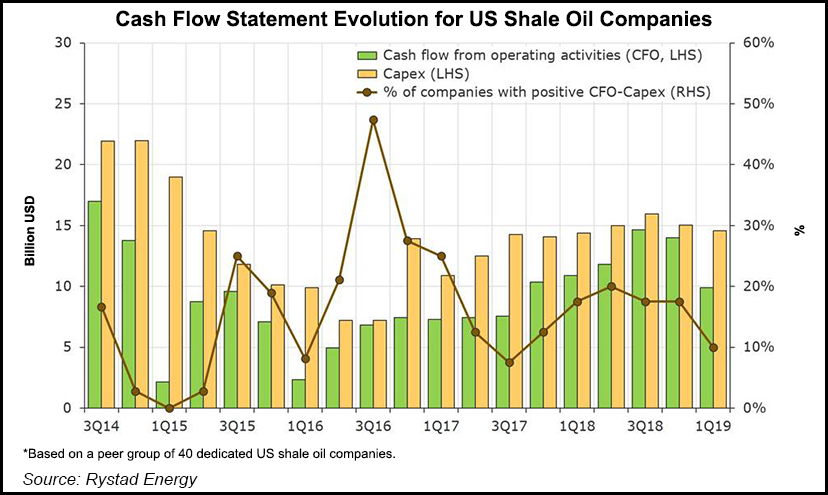Shale Daily | E&P | NGI All News Access | NGI The Weekly Gas Market Report
Most Lower 48 E&Ps Reportedly Facing Uphill Climb to Positive Cash Flow
Nearly 90% of U.S. unconventional operators are burning cash, and many have not achieved a positive cash flow balance, according to a study of the financial performance of 40 companies.

Rystad Energy’s analysis of the exploration and production companies issued on Wednesday focused on cash flow from operating activities (CFO). CFO is cash available to expand the business via capital expenditures (capex) that help to reduce debt or to return to shareholders.
Only four companies in Rystad’s peer group reported a positive cash flow balance in 1Q2019, reducing the share of E&Ps with a positive balance from the recent norm of around 20% to only 10%.
Total CFO fell from $14 billion in 4Q2018 to $9.9 billion in the first quarter.
“That is the lowest CFO we have seen since the fourth quarter of 2017,” said senior analyst Alisa Lukash, who is part of Rystad’s North American Shale team. “The gap between capex and CFO has reached a staggering $4.7 billion. This implies tremendous overspend, the likes of which have not been seen since the third quarter of 2017.”
With negative cash flows, unconventional producers historically have relied on bond markets to finance their operations. Without additional funding and any debt refinancing, capex would have to be reduced, Rystad noted.
However, no U.S. onshore producer has made a public offering since the sharp decline in oil prices, and subsequent share price slide, late last year, “marking the longest gap in public capital issuance since 2014,” analysts said.
During March and April a few of the “more indebted operators” issued bonds, partly to cover outstanding obligations for the coming year. However, pricing for bonds has risen, Rystad said, because of the increased Fed Reserve Bank rate and the overall increased risk associated with U.S. oil companies from a market perspective.
“Recently released data, which confirmed dismal first quarter earnings, only served to cement negative market sentiment,” Lukash said. “While shale operators continue to focus on improving capital efficiency, investors are putting the industry under extreme pressure, leaving no room for undisciplined spending in 2019.”
Many operators are building production momentum today after a seasonal dip during the winter months. As oil prices improve, Rystad analysts expect the second quarter to see a “significant increase in CFO while capex remains stable.”
Most U.S. E&Ps have reduced their long-term debt slightly by paying down obligations that are expected to reach maturity soon. Reducing the debt is supporting the deleveraging goals of many E&Ps.
“When considering available cash for a potential stockholder payback, the majority of U.S. shale oil operators saw free cash flow to equity below zero in the first quarter,” Lukash said.
In the last half of this year, Rystad’s team expects drilling activity to remain robust, potentially increasing transaction volumes rather than inducing an inflow of capital into the industry.
“Larger diversified operators, which have multiple cash generating engines and are more resistant to volatile commodity prices, will be especially poised to open up to acquisition of new acreage,” Lukash said.
© 2024 Natural Gas Intelligence. All rights reserved.
ISSN © 2577-9877 | ISSN © 1532-1266 | ISSN © 2158-8023 |
